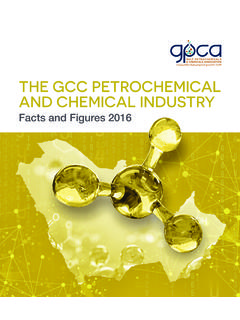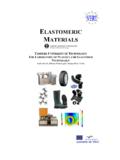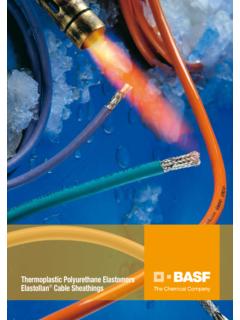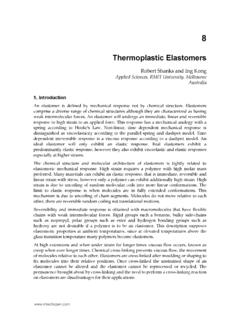Transcription of THERMOPLASTIC - gpca.org.ae
1 THERMOPLASTIC elastomers INDUSTRYIN THE GCC REGIONCONTENTSI ntroduction 4 Global THERMOPLASTIC elastomers industry 5 THERMOPLASTIC polyolefin elastomers (TPO) 6 GCC THERMOPLASTIC elastomer industry 16 Conclusions 21 THERMOPLASTIC elastomers (TPEs) perform like thermoset rubbers but can be processed using standard THERMOPLASTIC processing equipment and techniques. They can be melted, deformed and recycled easily. Due to their improved properties, soft-touch , they are replacing thermoplastics and standard elastomers (where higher performing cross linked properties are not required) despite their higher cost.
2 TPEs are mainly used in the automotive industry, construction industries, plastic engineering, wire and cable, and medical applications. They are split into five main groups as displayed in Figure for TPEs was historically focused on the US, the European Union (EU) and Japan, but the first TPE plants will start up in late 2016 and 2017 in the Gulf Cooperation Council (GCC) Rabigh Refining & Petrochemical Company (PetroRabigh) which is owned by Saudi Aramco ( ), Japan s Sumitomo Chemical ( ) and the public (25%), is building a TPO plant at Rabigh, Saudi Arabia which is expected to be completed in Q2, plant will use the Sumitomo owned ESPOLEXTM (superscript please) brand.
3 Sadara, a 50/50 joint venture (JV) between Saudi Aramco and Dow Chemical, started up a polyolefin elastomers plant in late 2016 at Al Jubail, Saudi Arabia. Dow, which owns the AFFINITY and ENGAGE POE brands, will provide the technology used by Sadara. Al-Jubail Petrochemical Company (KEMYA), a 50/50 JV between SABIC and Exxon Chemical Arabia, has opened a polyolefin elastomers plant in Jubail. What follows is a brief overview of the global TPE industry, after which this report will focus on THERMOPLASTIC polyolefin elastomers (TPOs).Figure THERMOPLASTIC elastomer types Sadara, Kemya - 2016 PetroRabigh - 2017 THERMOPLASTIC Polyolefin elastomers (TPOs or TPEs-O) THERMOPLASTIC Urethanes (TPUs) THERMOPLASTIC elastomers (TPEs) Styrene-Butadiene- Styrene (SBS) Styrenic Block Copolymers (SBCs) Styrene-Isoprene- Styrene (SIS) Styrene-Ethylene/Propylene-Styrene (SEPS) Hydrogenated SBS (SEBS) Styrene-Ethylene/Ethylene/Propylene-Styr ene (SEEPS) Styrene-Isoprene-Butadiene-Styrene (SIBS)
4 Aliphatic Ether Ester In-situ TPOs THERMOPLASTIC Vulcanizates (TPVs) Polyolefin elastomers (POEs) Compounded TPOs Copolyester THERMOPLASTIC elastomers (COPEs) Polyether-Block-Amide (PEBA or COPA) Olefin Block Copolymers (OBCs) Source: Nexant| THERMOPLASTIC elastomers Industry in the GCC Region4 THERMOPLASTIC elastomers (TPEs) perform like thermoset rubbers, the traditional elastomers , but can be processed using standard THERMOPLASTIC processing equipment and techniques. They can be repeatedly melted, cooled, deformed without affecting the product quality and can be recycled easily. TPEs also have a broader range of properties such as high impact resistance, high strength, shrink resistance and superior aesthetic finishes compared to traditional some instances, where the final application does not require the performance of a crosslinked rubber, they can substitute conventional elastomers such as isoprene rubber (IR), polybutadiene (BR), chloroprene (CR), butyl rubber (IIR), styrene butadiene rubber (SBR) or nitrile rubber (NBR) as TPEs are easier and faster to process at a lower cost.
5 TPEs are split into five main groups as shown in Figure : styrenics block copolymers (SBCs) which consist of polystyrene and rubber blocksGlobal THERMOPLASTIC elastomers industry THERMOPLASTIC polyolefin elastomers including THERMOPLASTIC vulcanizates (TPVs), THERMOPLASTIC urethane (TPUs), copolyester THERMOPLASTIC elastomers (COPEs), polyether block amides (PEBAs or COPAs).They are mainly used in the automotive industry, construction industry, wire and cable and medical applications, and can be processed by injection moulding, blow moulding, thermoforming and extrusion. Growing demand for lightweight, high performance materials in the automotive industry is expected to be the main driver behind TPE demand growth.
6 The second driver is the increasing pressure from regulators to replace PVC with more eco-friendly products such as TPEs in the automotive and construction Global TPE demand by type, 2016 (estimate)( million tons)Source: NexantSBC39% TPO (including TPV)38% TPU9% COPE6% COPA,8% THERMOPLASTIC elastomers Industry in the GCC Region |5 THERMOPLASTIC polyolefin elastomers (TPO)Advances in catalysis metallocenes and other Ziegler-Natta catalysts have enabled the production of a wide range of THERMOPLASTIC polyolefin elastomers that are generally grouped into the following categories: in-situ THERMOPLASTIC polyolefin elastomer (TPOs made in the reactor also referred to as r-TPOs) compounded TPOs polyolefin elastomers (POEs) olefin block copolymers (OBCs) THERMOPLASTIC vulcanizates (TPVs)
7 The following table summarises their typical composition, key sectors driving their demand and average annual demand growth rate over the last five TPO types, drivers and historical growth ratesTPOs typesTypical compositionDriving sectors2011-2016 Average annual growth rate, global in %In-situ TPO20-40% ethylene, remaining mostly propylene + small amount of butene-1 or octene-1 Automotive, Compounded TPO20-40% elastomer (such as EPDM), remaining mostly THERMOPLASTIC (such as PP)Mainly ethylene, 9-35% linear alpha olefins (LAOs) or 70-90% propylene, 10-30% ethylene or butene-1 Packaging film, footwear and LAO copolymer or polypropylene/ethylene propylene copolymerAutomotive, construction, EPDM, 30-40% PPAutomotive, construction, THERMOPLASTIC polyolefin elastomerDemandAn in-situ TPO (also referred to as a reactor TPO) is defined as a polyolefin material containing between 10 and 40% ethylene as produced in the reactor with the remaining composition being mostly propylene.
8 Small amounts of additional co-monomers, such as octene-1 or butene-1, may also be present, so as to provide unique functionality. The majority of in-situ TPOs are between 20 to 40 weight percent ethylene as polymers with less than 20% ethylene are fairly hard and usually have poor elastomeric properties; these are classified as impact polypropylenes. Polymers containing greater than 40% ethylene are quite soft and have relatively poor elastomeric properties.| THERMOPLASTIC elastomers Industry in the GCC Region6 Table In-situ TPO AAGR by region, 2011-2016 (thousand tons per year)20112016 Annual average growth rate, % (2011-2016)North of the TPOs compete to some extent against compounded TPOs (detailed in the next sub-section).
9 However, high elastomer content in-situ TPOs are difficult to produce and high levels of other additives, especially colorants such as carbon black, must still be added. This has largely relegated in-situ TPOs to applications with either low ethylene content, or where dispersing other ingredients can be done easily during fabrication. In-situ materials are used to reduce cost and increase the end use value in cases where the TPO does not need to be compounded prior to fabrication. Displacement of compounded TPOs by in-situ materials appears to have largely run its course. The main application of in-situ is automotive exterior and bumpers, impact modifiers, interior head impact trim, under-the-hood impact, cladding, wire harness, and weather strip followed by construction roofing by regionGlobal demand in 2016 is estimated at 414 000 metric tons, as shown in Figure and Table in-situ TPO growth averaged between 2011 and 2016, while North American demand increased as the automotive sector and residential construction sector recovered.
10 Growth in Western Europe and Japan has been slow due to weak economic conditions and the progressive automotive industry relocation as production of fabricated parts moves to lower labour cost regions such as Central and Eastern Europe and the rest of Asia, China and India in particular. Figure In-situ TPO by region, 2016 (estimate)(414,000 tons)North America38% Western Europe33% Japan12%GCC2%Rest of the world15% Source: NexantThermoplastic elastomers Industry in the GCC Region |7 Demand by applicationCurrently, automotive applications remain the largest outlet for in-situ TPOs, accounting for an estimated 75% of global demand.











